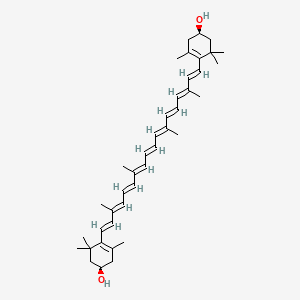Zeaxanthin
Zeaxanthin is a lipid of Prenol Lipids (PR) class. Zeaxanthin is associated with abnormalities such as Disintegration (morphologic abnormality), Alkalemia, Age related macular degeneration, Visual impairment and Consumption-archaic term for TB. The involved functions are known as Signal, Regulation, Energy Transfer, Process and Pigment. Zeaxanthin often locates in Chloroplast thylakoids, reaction center, Tissue membrane, PSII associated light-harvesting complex II and Thylakoid Membrane. The associated genes with Zeaxanthin are PRB2 gene, Structural gene, Polypeptides, Genes, Bacterial and Genes, rRNA. The related lipids are Membrane Lipids, Micelles, Fatty Acids, Lipid Peroxides and monogalactosyldiacylglycerol. The related experimental models are Knock-out.
References related to locations published in Others
| PMID | Journal | Published Date | Author | Title |
|---|---|---|---|---|
| 12671093 | Plant Cell | 2003 | Baroli I et al. | Zeaxanthin accumulation in the absence of a functional xanthophyll cycle protects Chlamydomonas reinhardtii from photooxidative stress. |
| 10618204 | Appl. Environ. Microbiol. | 2000 | Lagarde D et al. | Increased production of zeaxanthin and other pigments by application of genetic engineering techniques to Synechocystis sp. strain PCC 6803. |
| 11181717 | J. Exp. Bot. | 2001 | Jin X et al. | The hypocotyl chloroplast plays a role in phototropic bending of Arabidopsis seedlings: developmental and genetic evidence. |
| 20698886 | FEMS Microbiol. Ecol. | 2010 | Weinert N et al. | Bacterial diversity on the surface of potato tubers in soil and the influence of the plant genotype. |
| 21106934 | FASEB J. | 2011 | Amengual J et al. | A mitochondrial enzyme degrades carotenoids and protects against oxidative stress. |
| 19638474 | Plant Cell | 2009 | Arnoux P et al. | A structural basis for the pH-dependent xanthophyll cycle in Arabidopsis thaliana. |
| 19376893 | Appl. Environ. Microbiol. | 2009 | Weinert N et al. | Rhizosphere communities of genetically modified zeaxanthin-accumulating potato plants and their parent cultivar differ less than those of different potato cultivars. |
| 18319463 | Int. J. Syst. Evol. Microbiol. | 2008 | Asker D et al. | Nubsella zeaxanthinifaciens gen. nov., sp. nov., a zeaxanthin-producing bacterium of the family Sphingobacteriaceae isolated from freshwater. |
| 18385086 | Invest. Ophthalmol. Vis. Sci. | 2008 | Kowluru RA et al. | Beneficial effect of zeaxanthin on retinal metabolic abnormalities in diabetic rats. |
| 15749754 | Plant Cell | 2005 | Dall'Osto L et al. | A mechanism of nonphotochemical energy dissipation, independent from PsbS, revealed by a conformational change in the antenna protein CP26. |
| 15557295 | J. Exp. Bot. | 2005 | Horton P and Ruban A | Molecular design of the photosystem II light-harvesting antenna: photosynthesis and photoprotection. |
| 16258032 | Plant Cell | 2005 | Havaux M et al. | Vitamin E protects against photoinhibition and photooxidative stress in Arabidopsis thaliana. |
| 16893979 | J. Exp. Bot. | 2006 | Heber U et al. | Thermal energy dissipation in reaction centres and in the antenna of photosystem II protects desiccated poikilohydric mosses against photo-oxidation. |
| 16551690 | J. Exp. Bot. | 2006 | Heber U et al. | Conservation and dissipation of light energy as complementary processes: homoiohydric and poikilohydric autotrophs. |
| 22582723 | FEMS Microbiol. Lett. | 2012 | Hameed A et al. | Siansivirga zeaxanthinifaciens gen. nov., sp. nov., a novel zeaxanthin-producing member of the family Flavobacteriaceae isolated from coastal seawater of Taiwan. |
| 23898030 | Plant Cell | 2013 | Janik E et al. | Molecular architecture of plant thylakoids under physiological and light stress conditions: a study of lipid-light-harvesting complex II model membranes. |
| 26541886 | Prog Retin Eye Res | 2016 | Bernstein PS et al. | Lutein, zeaxanthin, and meso-zeaxanthin: The basic and clinical science underlying carotenoid-based nutritional interventions against ocular disease. |
| 27538825 | J. Lipid Res. | 2016 | Thomas SE and Harrison EH | Mechanisms of selective delivery of xanthophylls to retinal pigment epithelial cells by human lipoproteins. |
| 27389691 | J. Lipid Res. | 2016 | Palczewski G et al. | Genetic dissection in a mouse model reveals interactions between carotenoids and lipid metabolism. |
| 25502844 | J. Lipid Res. | 2015 | Nagao A et al. | A 3-hydroxy β-end group in xanthophylls is preferentially oxidized to a 3-oxo ε-end group in mammals. |
| 26482868 | Free Radic. Biol. Med. | 2015 | Olchawa MM et al. | Zeaxanthin and α-tocopherol reduce the inhibitory effects of photodynamic stress on phagocytosis by ARPE-19 cells. |
| 25002123 | FASEB J. | 2014 | Palczewski G et al. | Evidence for compartmentalization of mammalian carotenoid metabolism. |
| 24014548 | Plant Cell | 2013 | Pinnola A et al. | Zeaxanthin binds to light-harvesting complex stress-related protein to enhance nonphotochemical quenching in Physcomitrella patens. |
